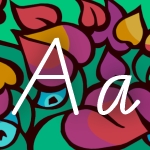
 |
Letter Explorer |
This game helps children to learn about the letters of the alphabet. Each letter has seven games to engage them and enhance different skills.
On opening the game the target letter is introduced and the icons for the seven activities appear at the left side of the screen. They are as follows:
| Jigsaw make the letter using jigsaw pieces | |
| Look sort letters by visual recognition | |
| Sound sort pictures by verbal recognition of initial letter | |
| Find identify the letter in words | |
| Catch identify and catch the letter amongst others | |
| Draw draw the letter using a template | |
| Type type the letter when it appears |
A guide to each activity is below.
In each activity there is a help button to remind children of the aim of the game and the target letter. Children can swap between activities at any time by clicking on the icons.
To exit, click on the hand in the upper right corner of the screen.
Outcome 4: Children are involved and confident learners
Outcome 5: Children are effective communicators
Identifying letters of the alphabet verbal and visual recognition
Upper and lower case letters
Using a keyboard QWERTY keys and spacebar
Observation skills
Listening skills
Decision-making
Same/different identification
Mouse control - single click
Mouse control - click and drag
Jigsaw pieces are arranged next to a grid. Click and drag the pieces onto the grid to make the letter that appears above it. Pieces will lock into place when positioned correctly and bounce back if incorrect. When completed the target letter will change from lower to upper case.
Two containers are at the bottom of the screen, one with the target letter written on its side in upper and lower case. An object with a letter is above them. Drag it into the correct container, depending on the letter. If the object does not have the target letter, place it in the blank container.
The objects and the target container, when clicked, will name the letter and the sound they make.
Two barrels are at the bottom of the screen, one with the target letter written on its side in upper and lower case. Six objects are above them. Their names and starting letter sound will play when they are clicked. Drag each into the correct container, depending on the sound the objects starting letter makes. If objects are placed incorrectly, they will bounce back to their original positions.
A sentence appears on the screen, with the target letter below it. Click on this letter each time it appears in the sentence. It will change colour. When all of the target letters are found a picture will appear.
The target letter is shown next to the frog. Ten letter bubbles are released. Click on all the bubbles with the correct letter, which may be upper or lower case.
Pick a colour at the bottom of the screen and practise making the letter by drawing over the dotted lines. Start at number 1 and draw in the direction of the arrow, then 2 and 3. Have fun decorating the rest of the screen. Clear the screen by clicking on the sponge to the right of the colour palette.
On the screen is a QWERTY keyboard with the target letter and a pair of hands below it. When a letter matching the target letter appears above the keyboard, type the same letter on the screen keyboard or one attached to the computer. An object that starts with the target letter will then appear. If the letter does not match the target letter, press the spacebar.
The letters on the screen keyboard can be changed from lower case to upper case by clicking on the blue button at the right of the screen.
Note: the object of this game is to find the target letter, not any other letters shown. The actions taken should be either to press the target letter or the spacebar on the keyboard. When a letter appears, finger/s will be coloured. This shows the recommended finger to be used for the action and is to help children become familiar with using different fingers and hands on the keyboard.
Most educators agree that typing is an essential tool for us all to learn, and the younger the better. Keyboards are everywhere these days and take many forms, e.g. computer keyboard, tablet screens, mobile phones. Familiarity with their appearance and use is an important skill for children to learn.
Typing allows us to record thoughts quickly. Being confident with this skill means that we can fully concentrate on ideas that we want to record, and not be distracted by the process. Finding keyboarding effortless benefits older children and with early introduction this is more likely to occur.
Children at any age can become familiar with keyboards. It is great for letter recognition and hand/eye coordination. Learning how to use them can be fun and challenging.
It is generally thought that touch typing (typing without looking at the keys) can be taught to children from age 7 to 8 upwards. This is considered the age that finger span and motor coordination is sufficient to start learning the skill.